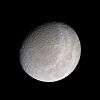Setebos (moon)
|
Discovery image of Setebos (encircled) | |
| Discovery | |
|---|---|
| Discovered by | |
| Discovery date | July 18, 1999 |
| Designations | |
| Adjectives | Setebosian |
| Orbital characteristics | |
Mean orbit radius | 17,418,000 km[1][2] |
| Eccentricity | 0.5914[2] |
| 2225.21 d | |
| Inclination | 158° (to the ecliptic)[1] |
| Satellite of | Uranus |
| Physical characteristics | |
Mean radius | 24 km (estimate)[3] |
| ~7200 km² (estimate) | |
| Volume | ~58,000 km³ (estimate) |
| Mass | ~7.5×1016 kg (estimate) |
Mean density | ~1.3 g/cm³ (assumed) |
| ~0.0204 km/s (estimate) | |
| ? | |
| ? | |
| Albedo | 0.04 (assumed)[3] |
| Temperature | ~65 K (estimate) |
|
| |
Setebos (/ˈsɛtᵻbʌs/ SET-ə-bus) is one of the outermost retrograde irregular satellites of Uranus. It was discovered on 18 July 1999 by John J. Kavelaars et al. and provisionally designated S/1999 U 1.[4]
Confirmed as Uranus XIX, it is named after the god worshipped by Caliban and Sycorax in William Shakespeare's play The Tempest.
The orbital parameters suggest that it may belong to the same dynamic cluster as Sycorax and Prospero, suggesting common origin.[5] However, this suggestion does not appear to be supported by the observed colours. The satellite appears neutral (grey) in visible light (colour indices B-V=0.77, R-V=0.35),[6] similar to Prospero but different from Sycorax (which is light red).
Ironically, a crater on Umbriel is also named after Setebos, but with the spelling Setibos.
See also
References
- 1 2 Sheppard, Jewitt & Kleyna 2005, p. 523, Table 3.
- 1 2 Yeomans, Donald K. (2007-06-28). "Planetary Satellite Mean Orbital Parameters". JPL/NASA. Retrieved 2008-01-19.
- 1 2 Sheppard, Jewitt & Kleyna 2005, p. 523, Table 3 ... ri (km) ... 24 ... i Radius of satellite assuming a geometric albedo of 0.04.
- ↑ Gladman, B. J.; Kavelaars, J. J.; Holman, M. J., Petit, J.-M.; Scholl, H.; Nicholson, P. D.; and Burns, J. A.; The Discovery of Uranus XIX, XX, and XXI, Icarus, 147 (2000), pp. 320–324
- ↑ Grav, Tommy; Holman, Matthew J.; Gladman, Brett J.; and Aksnes, Kaare; Photometric survey of the irregular satellites, Icarus, 166, (2003), pp. 33–45. arXiv:astro-ph/0301016
- ↑ Grav, Holman & Fraser 2004.
- Grav, Tommy; Holman, Matthew J.; Fraser, Wesley C. (2004-09-20). "Photometry of Irregular Satellites of Uranus and Neptune". The Astrophysical Journal. 613 (1): L77–L80. arXiv:astro-ph/0405605
 . Bibcode:2004ApJ...613L..77G. doi:10.1086/424997.
. Bibcode:2004ApJ...613L..77G. doi:10.1086/424997. - Sheppard, S. S.; Jewitt, D.; Kleyna, J. (2005). "An Ultradeep Survey for Irregular Satellites of Uranus: Limits to Completeness". The Astronomical Journal. 129: 518. arXiv:astro-ph/0410059
 . Bibcode:2005AJ....129..518S. doi:10.1086/426329.
. Bibcode:2005AJ....129..518S. doi:10.1086/426329.
External links
- Setebos Profile (by NASA's Solar System Exploration)
- David Jewiit pages
- Uranus' Known Satellites (by Scott S. Sheppard)
- MPC: Natural Satellites Ephemeris Service


